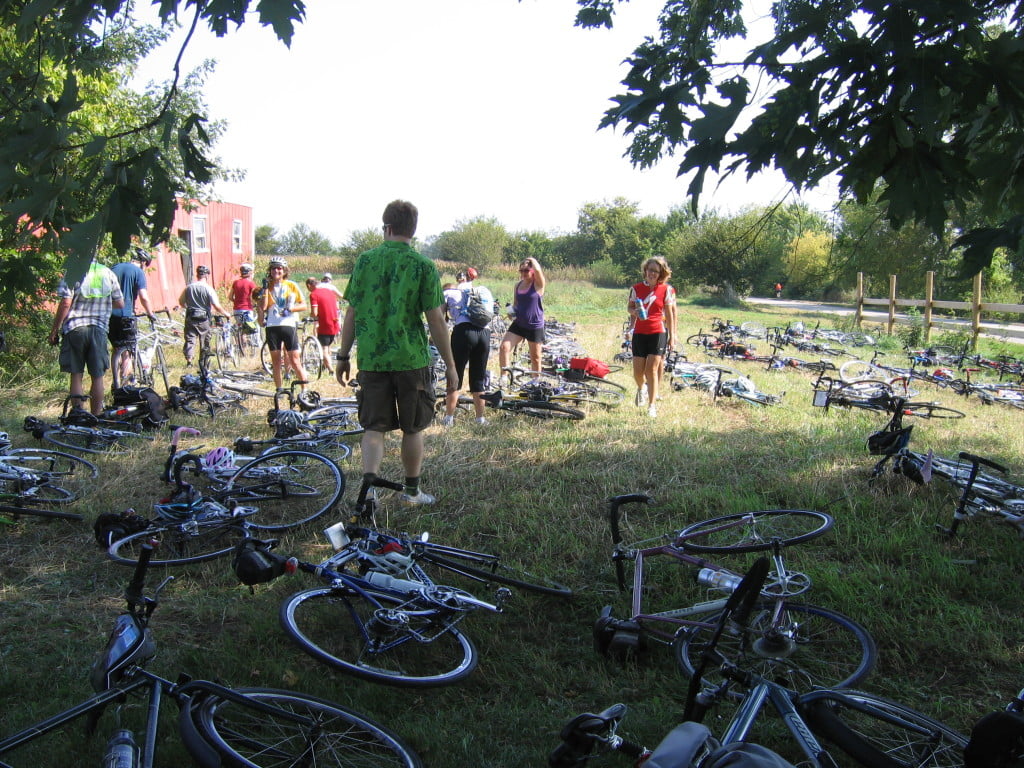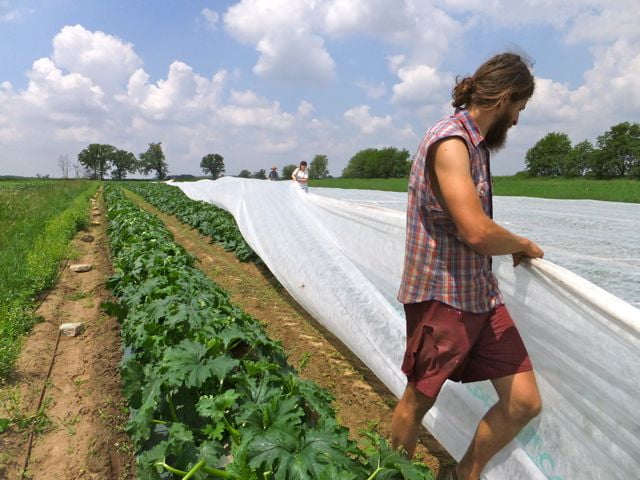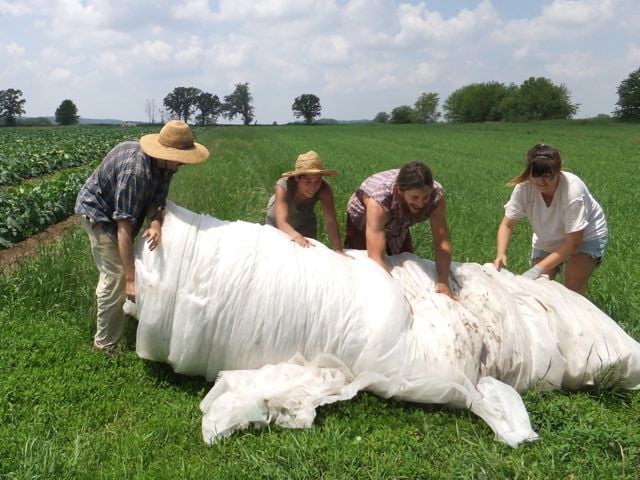Monthly Archives: June 2013
Camaraderie
- On: June 26, 2013
 0
0
A new employee remarked on the camaraderie among the work crew. That’s how we get through difficult jobs. Yesterday we sent everyone to pick peas in a muddy, muddy field. People sank ankle-deep into the mud. By this morning, everyone had a funny story to tell about the experience. Steve and I were relieved – we knew it had been a difficult task. But it was OK because everyone was together, it was warm, the rain had stopped, and the peas were in beautiful shape and therefore were enjoyable to pick.
It was a dry month for us – until Friday. Surprised? The storms drenching southern Wisconsin slipped by our farm until Friday. It was eerie to watch them on the weather maps. It’s been so dry that we began irrigating two weeks ago. We can put the irrigation equipment away for a while. We got six inches of rain in six days. That’s plenty. We hope it will stay dry for the next week to protect our strawberry crop. The berries we picked this week are quite soft because of the rain. Plan to eat them right away, as they will not store well.
Strawberry U-Pick
Check this week’s email for u-pick information.
Reminder: We will make our Thursday deliveries on Wednesday July 3 next week. Friday deliveries will be on July 5, as scheduled.
Veggie List and Veggie Notes
Strawberries, 2 quarts
Sugar snap peas, 1.75 lb
Zucchini/summer squash, 3+ lb
Collard greens, 1 bunch
Rhubarb, about 1 lb
Garlic scapes
Broccoli (about 1 lb) OR kohlrabi (1 – 2 bulbs)
Next week’s box will probably contain strawberries, sugar snap peas, zucchini and summer squash, spinach, basil and more
Strawberries – The berries are soft because of the rain, and should be eaten promptly.
Garlic scapes (curly green things) – We buy these from John Hendrickson of Stone Circle Farm who is growing organic garlic for our CSA again this year. The scapes grow at the top of garlic plants. John snaps them off to direct the plants’ energy into forming garlic bulbs underground. Use scapes as a substitute for garlic cloves. They can be minced, mixed with olive oil, and added to stir fries or simple pasta dishes. The scapes can be sautéed, but will not brown like garlic cloves. Expect them to retain their crunch even when cooked, and to be milder than garlic cloves, closer in pungency to the green garlic we’ve sent.
Bike the Barns at our farm this year.
- On: June 19, 2013
 0
0
Our farm has been chosen to host the lunch stop for FairShare’s Bike the Barns fundraiser this year. This is a big honor. When we hosted the event in 2008, I was nervous about accommodating 600 bicyclists and their cycles. It was easy. We discovered that 600 people+bikes don’t take up that much space. The ride begins and ends in lovely Lake Leota park in Evansville.
Registration is open for the ride. Go here for information and to register. There are two routes this year. Choose the 30 mile route or the 70 mile route. Both routes stop at our farm. Registration opened on June 17 and 120 riders have already signed up. I see a few Tipi members among them!
Strawberry U-Picks.
Please read this week’s email for information about upcoming strawberry u-picks at our farm. The u-picks are for Tipi members only, so I don’t post the details on-line. Check your email this week and next.
July 4 schedule.
The holiday falls on a Thursday this year. WE WILL DELIVER TO OUR THURSDAY SITES on WEDNESDAY JULY 3. Friday deliveries will not change and boxes will be delivered on Friday July 5, as scheduled. It is a purple EOW week.
Veggie List and Veggie Notes. This is the final asparagus delivery. It’s been an excellent year for asparagus but now it’s time to let the plants grow and store root reserves for next year. We’re thrilled to send asparagus to you folks for five weeks. That’s the most we can expect. This week, we will pack …
Asparagus, 0.8 lb
Strawberries. Most will get 1 pt. A few sites will get 1 quart.
Snap peas, l lb
Zucchini/summer squash, about 3 lb
Rainbow Swiss chard, 1 bunch
Red bibb lettuce
Scallions, 1 bunch
Broccoli (1.1 lb) OR kohlrabi with greens
Next week’s box will probably contain strawberries, snap peas, zucchini and summer squash, garlic scapes, broccoli OR kohlrabi, greens and more.
Strawberries! – These first berries are Annapolis, our earliest variety and always the first ready to harvest. These are the largest Annapolis berries we’ve ever grown. The first flowers on Annapolis are almost always lost to frost. That’s the risk with early varieties. The flowers survived this year, giving us large “king” berries in our first harvest.
♦ Strawberries are perishable. Ripe berries should be eaten immediately, or stored in the refrigerator. Most berries are quite clean. If you want to clean your berries, rinse gently. Don’t soak them, just rinse. Do not be concerned if you receive a partially-filled container. Sometimes we fill them partially in order to distribute berries to all the members.
♦ Please recycle your strawberry containers this year. We no longer collect them for re-use.
Snap peas – These peas should be eaten pod and all. They are delicious raw, or very lightly cooked or stir-fried. They might need a quick rinse to remove faded gray blossoms. Store in the refrigerator. Here’s how to remove the strings from the snap peas. Snap off the stem end and pull the string down the concave side of the pod (the inward-curing side). Throw away the string and eat the pod.
Summer squash/zucchini – You will receive yellow summer squash or green zucchini. Some squash are oddly shaped but are fine to eat. This is typical for the first picking, and reflects that the first squash were not completely pollinated. The plants were hidden under row covers where pollinators couldn’t find them. The honeybees settled down to work once we removed the row covers and the newest squash look great.
Swiss chard (pretty bundle of greens with mixed-color stems) – This is a close relative of spinach, but requires a bit more cooking. Use as a substitute in any recipe that calls for spinach, just cook the chard a little longer. Both stems and leaves are delicious. The stems requite longer cooking, so cut them free from the leaves when preparing. That allows you to cook the stems longer.
Kohlrabi (green bulb with leaves) – See last week’s newsletter for information. The leaves have grown since last week, and are now the consistency of collard leaves. Remember to remove the stems before cooking the leaves. Peel the bulbs and use in salads.
Like folding a quilt
- On: June 12, 2013
 0
0
‘Twas time to unveil the zucchini field this week. We’ve kept the plants under row cover to speed their growth, but now it’s time to remove the covers to allow bees to pollinate the flowers. Big sheets of row cover are unwieldy. Our largest ones measure 50 feet by 500 feet, and cover more than a half acre. Here’s how to remove one from a field.
Step 1. Choose a calm, dry day. Wet row cover is astonishly heavy. Wind will carry it away.
Step 2. Gather a group of workers. Fold the cover lengthwise to remove it from the field. Fold repeatedly until the bundle is about 5 feet across. As Clint says “It’s like folding a quilt … a very big quilt.”
Step 3. Start to roll it up. One person can begin the roll but two are better.
Step 4. Add more helpers. By now the roll is getting heavy. Roll it quickly to make use of momentum.
Step 5. Finish the roll and collapse for a bit. Someone will carry the roll back to the buildings by tractor.
Member etiquette: Please scratch your name off the checkoff list.
It helps our site hosts identify unclaimed boxes. Thanks.
Scallion Ideas.
We are very enthusiastic about scallions at our house. Here are our favorite uses:
Scallion biscuits
*Scallion dumplings
Scallion pancakes
*Penne, spinach, asparagus and cashew salad, with scallion dressing
Egg drop soup with spring greens, topped with sliced scallions
*Grilled scallion, asparagus and turnip salad
Sliced scallions are good on sandwiches and salads
Grilled beef bulgogi wrapped in lettuce leaves. Easily adapted to tofu.
Salmon patties with scallions
* indicates the recipe is in the archives on our website
Veggie List and Veggie Notes.
Asparagus, 1.3 lb
Escarole, 1 head
Spinach, 1 medium bunch
White salad turnips with greens
Red bibb lettuce
Scallions, 1 bunch
Kohlrabi with greens OR broccoli, about 1 lb
Next week’s box will probably contain asparagus, peas, strawberries?, zucchini?, Swiss chard or other greens, broccoli OR kohlrabi and more.
Escarole (large green head that looks like lettuce) – This member of the chicory family can be eaten raw or cooked. Its slightly bitter flavor is a good addition to mixed salads. It is excellent cooked alone or mixed with other greens. It cooks quickly, but not as quickly as spinach. Refrigerate.
Spinach (small bundle of dark green leaves) – This is probably most useful for salad this week, as the quantity is small and leaves are tender. They will wilt down substantially when cooked. Plus there are all the other greens (turnip, escarole, and for some members kohlrabi) for cooking this week.
White salad turnips with greens (bundle of white roots with tops) – The turnip greens are tender again this week, and are good for cooking. Cook like mustard greens. The turnip roots are more abundant this week. There is minor insect damage on the roots this week, so some will need trimming.
Kohlrabi (round, pale green exterior, crisp white interior) – Kolrabi is an unusual vegetable that I enjoy introducing to new CSA members because almost everyone likes it. Crunchy and sweet, it’s a great addition to salads. Storage: Kohlrabi bulbs will store for a month in the refrigerator. Uses: Kohlrabi are good peeled and eaten out of hand, or added to sandwiches. It is good mixed into salads, or prepared as a salad on it’s own. You can grate it, slice it, or cut it into matchsticks. It’s also good cooked. If you have it, the Asparagus to Zucchini cookbook has a long list of kohlrabi suggestions.
The kohlrabi greens are quite nice this week and can be cooked. Steve tried a new variety with smaller, more tender leaves. Texture and waxiness are similar to young kale or collards. Cut out the midvein before cooking.
Remember, recipes and menus will be posted on the Local Thyme website each Thursday afternoon. Contact us if you need help setting up your account on the Local Thyme website.
Korean visitors
- On: June 05, 2013
 0
0
We hosted Korean visitors this week. It was an animated group of farmers, scientists and extension agents interested in organic agriculture. They asked many questions and wanted to touch everything. They were particularly interested in irrigation, cover crops, and the CSA. Their translator struggled to explain the CSA concept but they seemed to understand. We packed the CSA boxes with an attentive audience.
Steve showed them a field of pepper seedlings planted into rows covered with plastic mulch, similar to the onions in this post. Then he showed them the equipment he used to install the thin sheets of plastic, above. The translator could barely keep up with the questions and discussion.
Coopers Tavern dinner – Thanks to everyone who came to the Partner Shares benefit dinner at the Coopers Tavern. We enjoyed an excellent meal with current Tipi members, former Tipi members, former employees, food activists and old friends. My favorite dish was the pickled spring vegetable salad, a mix of individually pickled asparagus, radishes, bok choy stems and morel mushrooms. The asparagus was pickled in a fennel-scented brine, very yummy. The beer was donated by Peter Gentry of One Barrel Brewing Company. Peter was a member of our farm for many years, so it was fun to re-connect over our food and his beer.
This Week’s Box – I’ll list the box contents here (as well as in the sidebar) so it appears in the RSS feed and when printed. Weekly members and PURPLE every-other-week members get a box this week.
Asparagus, 1.25 lb
Spinach, medium bunch
White salad turnips with greens, 1 bunch
Romaine lettuce
Bok choy
Cilantro
Young scallions, 1 bunch
Rhubarb, 1.5 lb
Next week’s box will probably contain asparagus, white salad turnips, lettuce, scallions and more.
Veggie Notes
White salad turnips (bunched white roots with green tops) – I know that returning members look forward to these sweet and delicious turnips, which taste nothing like the turnips that are harvested in fall.
– Storage: Cover and refrigerate.
– Uses: Both the turnip roots and tops are edible. Slice the sweet roots and add to salads. They can be cooked and are especially good when lightly sauteed in butter. Stir as little as possible so they brown on at least one side. The turnips greens are excellent cooked. Treat them like mustard greens.
– Our favorite use: Slice the roots very thinly and combine with a mixture of rice vinegar, mirin, soy sauce, sesame oil. Eat immediately or marinate.
Bok choy (large rosette with thick white stems and green leaves) – This Asian green is good for stir-frying or sautéing or in soup. You can think of the stems and leaves as two separate vegetables. The stems require longer cooking. The leaves will cook almost as quickly as spinach. Bok choy stores well, so feel free to pull off leaves as you need them, or use the whole head at once. Refrigerate in a plastic bag.
– The plants started to bolt so we harvested them a bit younger than usual. You can eat the entire plant – cook the central stem with the leaf stems. Each spring, we face the decision of whether to cover the bok choy seedlings with row cover or not. They tend to bolt (flower prematurely) when under row cover, but get damaged by flea beetles if left unprotected. We tried both methods this spring. Wow, the uncovered ones were devoured by beetles. I’m glad we had these under cover.
Cilantro (bundle of fragrant green leaves) – This herb is good in salsa, chutneys and salad dressings, or added to stir-fries. Used in Mexican, Asian and Indian cooking. We are delighted to send cilantro in combination with bok choy and scallions because they are so tasty together.
Rhubarb – This is our last rhubarb delivery for a few weeks. We’ll send more once the strawberries are ready. Remember, rhubarb is easy to chop and freeze. We add frozen rhubarb to cakes, muffins, or pies. Rhubarb pancakes are excellent with sweetened yogurt.











